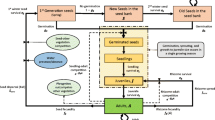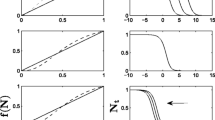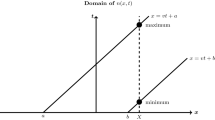Abstract
Tradescantia fluminensis is an invasive weed and a serious threat to native forests in eastern Australia and New Zealand. Current methods of eradication are often ineffective, so understanding the growth mechanisms of Tradescantia is important in formulating better control strategies. We present a partial differential equation (PDE) model for Tradescantia growth and spatial proliferation that accounts for Tradescantia’s particular creeping and branching morphology, and the impact of self-shading on plant growth. This is the first PDE model to represent a weed that spreads via a creeping growth habit rather than by seed dispersal. We use a travelling wave analysis to investigate how Tradescantia extends to colonise new territory. Numerical simulations and analysis show that the model provides a good qualitative representation of the behaviour of this plant. This model provides a foundation for assessing different control and eradication strategies for Tradescantia.







Similar content being viewed by others
References
Aikman D, Watkinson A (1980) A model for growth and self-thinning in even-aged monocultures of plants. Ann Bot 45(4):419–427
Balding D, McElwain D (1985) A mathematical model of tumour-induced capillary growth. J Theor Biol 114(1):53–73
Barnes P, Beyschlag W, Ryel R, Flint S, Caldwell M (1990) Plant competition for light analysed with a multi species canopy model, III: influence of canopy structure in mixtures and monocultures of wheat and wild oat. Oecologia 82(4):560–566
Bastian P, Chavarría-Krauser A, Engwer C, Jäger W, Marnach S, Ptashnyk M (2008) Modelling in vitro growth of dense root networks. J Theor Biol 254(1):99–109. doi:10.1016/j.jtbi.2008.04.014
Burns JH (2008) Demographic performance predicts invasiveness of species in the Commelinaceae under high-nutrient conditions. Ecol Appl 18(2):335–346. doi:10.1890/07-0568.1
Byrne H, Chaplain M (1995) Mathematical models for tumour angiogenesis: numerical simulations and nonlinear wave solutions. Bull Math Biol 57(3):461–486
CABI (2008) Tradescantia fluminensis. http://www.cabi.org/isc/datasheet/54389. Accessed 18 Nov 2015
Calado G, Duarte P (2000) Modelling growth of Ruppia cirrhosa. Aquat Bot 68(1):29–44. doi:10.1016/S0304-3770(00)00104-2
Edelstein L (1982) The propagation of fungal colonies: a model for tissue growth. J Theor Biol 98(4):679–701
Fowler SV, Barreto R, Dodd S, Macedo DM, Paynter Q, Pedrosa-Macedo JH, Pereira OL, Peterson P, Smith L, Waipara N, Winks CJ, Forrester G (2013) Tradescantia fluminensis, an exotic weed affecting native forest regeneration in New Zealand: ecological surveys, safety tests and releases of four biocontrol agents from Brazil. Biol Control 64(3):323–329. doi:10.1016/j.biocontrol.2012.11.013
Griffiths G, Schiesser WE (2011) Traveling wave analysis of partial differential equations. Elsevier, Amsterdam
Hogan A (2009) A mathematical model for the growth and spread of an invasive weed, Tradescantia fluminensis, Honours Thesis. School of Mathematics and Statistics, The University of Sydney
James A, Molloy SM, Ponder-Sutton A, Plank MJ, Lamoureaux SL, Bourdôt GW, Kelly D (2015) Modelling Tradescantia fluminensis to assess long term survival. PeerJ 3:e1013. doi:10.7717/peerj.1013
Kelly D, Skipworth JP (1984) Tradescantia fluminensis in a Manawatu (New Zealand) forest: I. Growth and effects on regeneration. N Z J Bot 22(3):393–397. doi:10.1080/0028825X.1984.10425270
Maule H, Andrews M, Morton J (1995) Sun/shade acclimation and nitrogen nutrition of Tradescantia fluminensis, a problem weed in New Zealand native forest remnants. N Z J Ecol 19(1):35–46
Murray JD (2002) Mathematical biology: I. An introduction, 3rd edn. Springer, New York
Perry LG, Neuhauser C, Galatowitsch SM (2003) Founder control and coexistence in a simple model of asymmetric competition for light. J Theor Biol 222(4):425–436. doi:10.1016/S0022-5193(03)00055-9
Standish R, Robertson AW, Williams PA (2001) The impact of an invasive weed Tradescantia fluminensis on native forest regeneration. J Appl Ecol 38(6):1253–1263
Standish R, Williams P, Robertson A, Scott NA, Hedderley DI (2004) Invasion by a perennial herb increases decomposition rate and alters nutrient availability in warm temperate lowland forest remnants. Biol Invasions 6(1):71–81. doi:10.1023/B:BINV.0000010127.06695.f4
Vance RR, Nevai AL (2007) Plant population growth and competition in a light gradient: a mathematical model of canopy partitioning. J Theor Biol 245(2):210–219. doi:10.1016/j.jtbi.2006.10.015
Wiles L, Wilkerson G (1991) Modeling competition for light between soybean and broadleaf weeds. Agric Syst 35(1):37–51
Acknowledgements
The authors thank Erin Walsh for creating the illustration of Tradescantia morphology; Charlie Macaskill for assistance with the numerical simulations; David Galloway for providing code to animate the travelling wave solution; and Kerry Landman for helpful discussions about the travelling wave analysis.
Author information
Authors and Affiliations
Corresponding author
Rights and permissions
About this article
Cite this article
Hogan, A.B., Myerscough, M.R. A Model for the Spread of an Invasive Weed, Tradescantia fluminensis . Bull Math Biol 79, 1201–1217 (2017). https://doi.org/10.1007/s11538-017-0280-7
Received:
Accepted:
Published:
Issue Date:
DOI: https://doi.org/10.1007/s11538-017-0280-7




